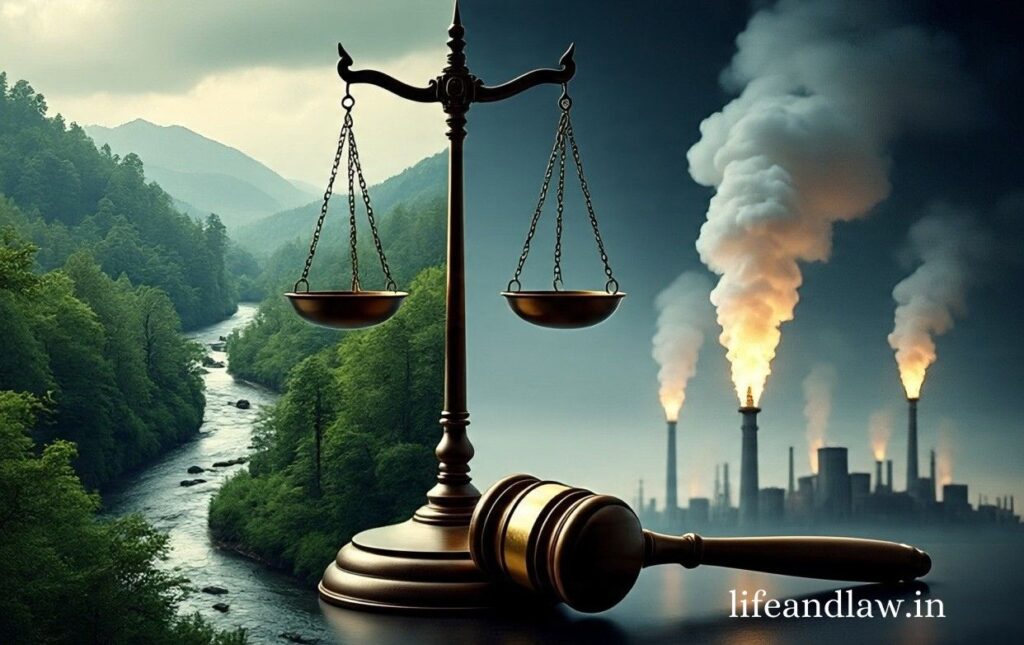Trending

Every year, July 28th is recognized as World Nature Conservation Day, acting as an important reminder that protecting the natural world is not just a moral responsibility, but also a legal requirement. With India facing increasing environmental challenges—from contaminated rivers to dwindling forests—the issue remains: Who represents nature’s interests? In an era when fast expansion frequently overshadows ecological concerns, nature requires a lawyer, and our legal systems must act as its voice and shield.
This article will look at how India’s legal system has evolved to preserve the environment, how courts and legislation shape ecological justice, and why implementing environmental law is critical to preserving our planet for future generations.
India is one of the world’s most biodiverse countries, but it also ranks among the most polluted. Environmental degradation has reached catastrophic levels, ranging from Delhi’s smog-choked air to the Sundarbans’ dwindling mangroves. Climate change, unchecked mining, deforestation, and plastic pollution are bringing ecosystems to the brink. These are not individual events; they are systemic failings that necessitate legal action.
Just as individuals have rights, so do ecosystems. Laws provide a framework for ensuring accountability, preventing harm, and setting conservation criteria. Without solid legal support, environmental protection may become empty rhetoric.
Since independence, India’s environmental governance has improved tremendously. Early post-independence regulations, such as the Indian Forest Act of 1927, were primarily colonial and exploitative in nature. However, the major transformation occurred during the 1970s and 1980s.
The Water (Prevention and Control of Pollution) Act, 1974 signaled the start of concentrated environmental legislation. This was followed by the Air (Prevention and Control of Pollution) Act, 1981, and, most importantly, the Environment (Protection) Act, 1986, which was passed following the Bhopal Gas Tragedy. This umbrella legislation permitted the central government to implement extensive environmental protection measures, and it remains the foundation of Indian environmental law today.
Several significant acts have shaped India’s environmental law landscape:
Wild Life (Protection) Act, 1972: One of India’s first comprehensive legislation targeted at protecting animals and their habitats. It resulted in the establishment of national parks and animal sanctuaries, as well as a ban on hunting endangered species.
Forest (Conservation) Act, 1980: This act established severe controls over the use of forest land for non-forest activities, requiring central government approval for any diversion of forest area.
Environment (Protection) Act, 1986: Perhaps India’s most powerful environmental law, it empowers the central government to take whatever necessary steps to maintain and improve environmental quality, control pollution, and establish safety standards.
India’s courts have frequently served as protectors of environmental rights. Citizens and non-governmental organizations (NGOs) have filed Public Interest Litigations (PILs) in court, resulting in landmark decisions on environmental issues.
The M.C. Mehta cases stand out. Whether it was cleaning the Ganga, relocating polluting industries, or prohibiting diesel vehicles in Delhi, these cases illustrated how the judiciary could hold governments accountable.
Under Article 21 of the Constitution, the Supreme Court construed the Right to Life to encompass the Right to a Healthy Environment. This inventive legal interpretation has given citizens the ability to demand action against pollutants and hold authorities accountable.
India is a signatory to various international accords, including the Paris Climate Agreement, the Convention on Biological Diversity, and the Stockholm Conference. These promises have an impact on domestic policies and regulations, accelerating India’s progress toward the Sustainable Development Goals.
India’s National Action Plan on Climate Change (NAPCC) and state-level climate action plans are inspired by these international duties, striving to reconcile economic progress with environmental integrity.
Despite India’s strong legislative structure, implementation remains a weak link. Many environmental regulations are not enforced effectively due to bureaucratic inefficiencies, lack of coordination, and political intervention. Regulatory authorities, such as the Central and State Pollution Control Boards, are frequently underfunded and understaffed.
Furthermore, environmental clearances are frequently expedited in the guise of “ease of doing business,” bypassing public consultations and ecological studies. The lowering of Environmental Impact Assessment (EIA) standards in recent years is a clear example of regulatory rollback.
The future of environmental legislation in India depends on enhancing accountability, decentralizing enforcement, and fostering citizen participation. The notion of “Rights of Nature”, which grants ecosystems legal personality, is gaining traction around the world and has the potential to influence Indian legislative reforms.
Furthermore, the emergence of Green Tribunals, particularly the National Green Tribunal (NGT), has resulted in a specialized platform for environmental justice. Corporate accountability is also changing, with Environmental, Social, and Governance (ESG) elements becoming more fundamental to company evaluations.
On World Nature Conservation Day, we are reminded that safeguarding the environment is a legal obligation, not merely a moral option. Strong legislation and enforcement are required to protect our natural resources and maintain ecological equilibrium.
Adv. Abdul Mulla, through www.asmlegalservices and www.lifeandlaw.in, highlights the importance of law and public responsibility in environmental protection. By supporting legal action and responsibility, we can all contribute to become nature’s advocates in both courtrooms and everyday life.
Adv. Abdul Mulla (Mob. No. 937 007 2022) is a seasoned legal professional with over 18 years of experience in advocacy, specializing in diverse areas of law, including Real Estate and Property Law, Matrimonial and Divorce Matters, Litigation and Dispute Resolution, and Will and Succession Planning. read more….
Copyright BlazeThemes. 2025